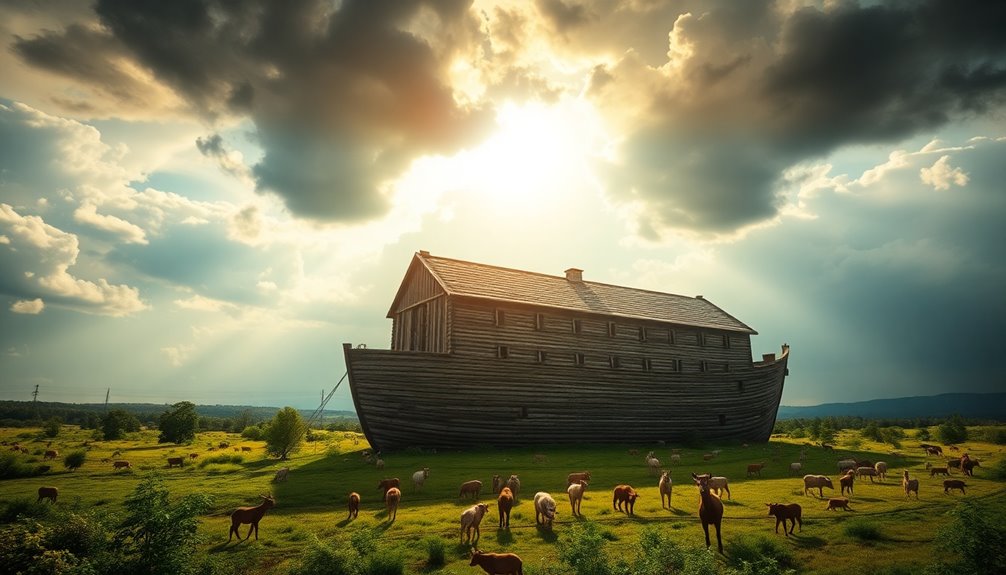Noah took about 50 to 100 years to build the Ark. His commitment to this monumental task highlights his unwavering faith and obedience to God's instructions. At 500 years old, he started constructing the Ark and was 600 by the time the Flood came. The timeline can sometimes be confusing due to various interpretations of biblical texts, but it clearly shows that Noah faced immense challenges and ridicule during this long process. If you're curious about the details surrounding his journey and how he maintained his faith, there's much more to uncover about this remarkable story.
Key Takeaways
- The construction of Noah's ark is estimated to have taken between 50 to 100 years.
- Genesis 6:3 refers to a 120-year period, often misinterpreted as the time for ark construction.
- Noah was 500 years old when he began building the ark and 600 when he entered it.
- The timeline suggests a significant spiritual journey alongside the physical construction efforts.
- Misunderstandings about the timeline frequently arise from misreading biblical texts.
Introduction
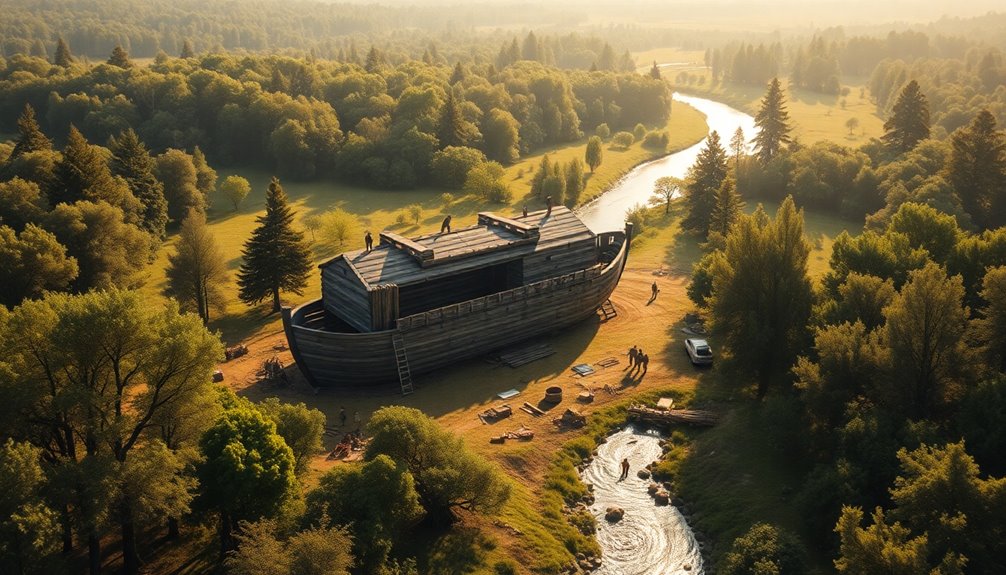
The story of Noah and the Ark is a profound narrative that raises questions about faith, obedience, and divine instruction. In Gênesis, we learn that God provided Noé with specific instruções for constructing the arca, which would save him and his family from the dilúvio.
You might wonder how long it took Noé to complete this monumental task. While the Bíblia doesn't specify the exact duration, estimates suggest it could have taken anywhere from 50 to 100 anos.
Consider this: Noé was 500 years old when his sons were born and entered the arca at 600. This timeline indicates that the construção of the arca likely spanned a significant portion of his life.
Throughout those years, Noé demonstrated unwavering fé, following God's instructions despite the absence of visible signs of the impending flood.
This lengthy commitment not only highlights Noé's dedication but also serves as a testament to the importance of patience and perseverance in faith.
As you delve deeper into the story, you'll see how Noé's actions resonate with the timeless themes of trust and obedience amidst uncertainty.
Biblical References to Noah's Faith
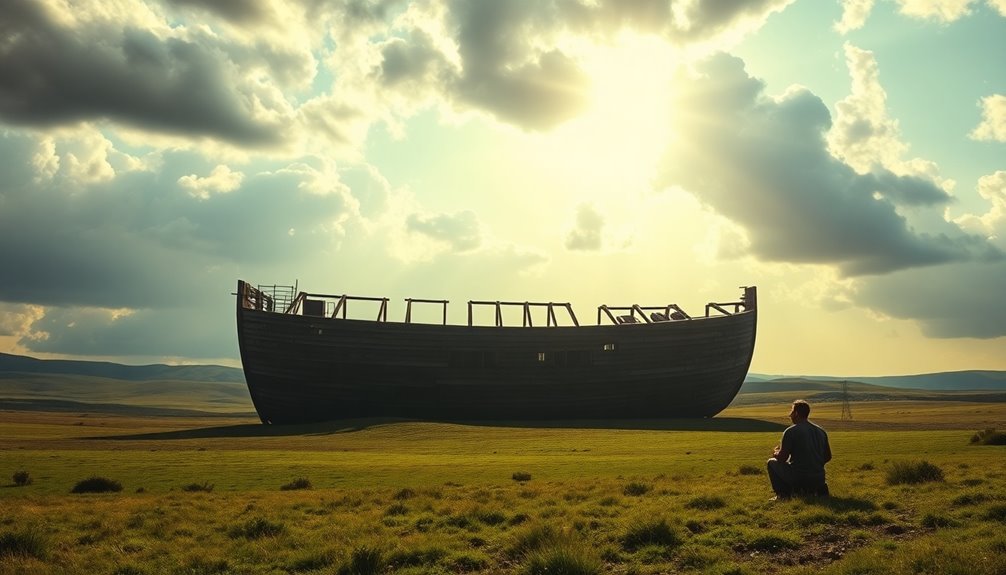
When you look at the biblical references to Noah's faith, you'll see a powerful example of obedience in the face of doubt.
He built the ark over many years, driven
Primary Bible References
Noah's faith is profoundly highlighted in several biblical references, showcasing his unwavering commitment to God's instructions. According to a timeline in the Bible, God granted humanity 120 years to repent before the Flood, which may suggest quanto tempo Noé levou para construir a arca.
While the exact duration isn't specified, estimates range from 50 to 100 years, indicating a significant period of labor and dedication. Notably, Noé tinha 600 anos when he entered the ark, emphasizing the long journey of obedience and faith.
As you explore these references, you'll find that os três filhos de Noé played a crucial role in helping their father with the construction. The use of madeira de cipreste, as instructed by Deus, reflects the importance of following God's specific guidelines.
Hebrews 11:7 honors Noah for his faith, pointing out that he acted on God's warnings about things not yet seen. This highlights his remarkable trust in God's plan to salvar a humanidade.
Finally, the New Testament reinforces this narrative, as Jesus mentions Noah and the Flood, solidifying the historical significance of Noah's actions in the face of disbelief.
Secondary Bible References
Through various secondary biblical references, Noah's faith stands out as a powerful testament to unwavering belief in God's promises. In Hebreus 11:7, it's clear that Noé acted on divine instruções, building the arca in reverent fear, trusting God's warnings about the impending dilúvio. This act of obediência underscores the immense time que Noé levou, not just in construction, but in preparation and warning others.
In 2 Pedro 2:5, Noé is described as um pregador de justiça, actively sharing God's message while he worked. This emphasizes his role in a society that largely ignored divine warnings.
Jesus also referenced Noé in Mateus 24:37-39, highlighting how judgment came unexpectedly, reinforcing the importance of faith even when surrounded by disbelief.
Ezequiel 14:14, 20 further cements Noé's place as a model of fé alongside figures like Daniel and Job.
These secondary references in the Bíblia consistently affirm that Noah's actions weren't mere obedience; they were a profound demonstration of faith that serves as a lesson for all believers. His story encourages you to trust and act on God's promises, no matter the societal skepticism.
Ancient Flood Narratives Worldwide

Across various cultures, ancient flood narratives reveal a shared human experience of disaster and survival. These narrativas de inundação illustrate how humanity confronts cataclysmic events, often guided by divine forces.
In the Epic of Gilgamesh, Utnapishtim constructs a boat to escape a great flood, symbolizing obedience to the gods and the preservation da vida. Similarly, in the Mahabharata, the god Vishnu, appearing as a fish, advises the king Manu to build a large vessel to save himself and the seeds of all plants, emphasizing the importance of divine guidance.
In Greek tradition, Deucalion and his wife Pyrrha survive a flood sent by Zeus as a form of divine judgment, showcasing the necessity of constructing a vessel to endure calamity.
Native American tribes, like the Ojibwe and Hopi, also share stories of chosen individuals or families who survive through divine intervention.
These traditions antigas echo common themes of obedience, preservation of life, and a higher power's role in humanity's survival. By examining these narratives, you can appreciate how different cultures interpret similar experiences, uniting them through tales of hope and resilience amidst disaster.
Duration of Ark Construction

The duration of the ark's construction is a topic of considerable interest, with estimates suggesting it could have taken anywhere from 50 to 100 years. Genesis 6:3 indicates a 120-year period for humanity to repent before the Flood, hinting that Noé levou para construir a arca a considerable amount of time.
When you consider that Noé tinha 500 anos quando foi mencionado pela primeira vez e 600 anos ao entrar na arca, é claro que a construção da arca foi um empreendimento longo.
During this período de obediência, Noé seguiu as instruções de Deus com firmeza. His unwavering faith and commitment to God's commands are evident in his dedication to construir a arca.
While the Bible doesn't specify the exact start date for the construction, the timeline inferred from Noé's age suggests that the ark's construction likely unfolded over several decades, supporting the idea that it might max out at around 100 years.
Ultimately, the tempos de Noé illustrate not just a physical effort but also a profound spiritual journey, showcasing Noé's obedience to God in a world that had largely turned away.
Ark Construction Timeline Confusion
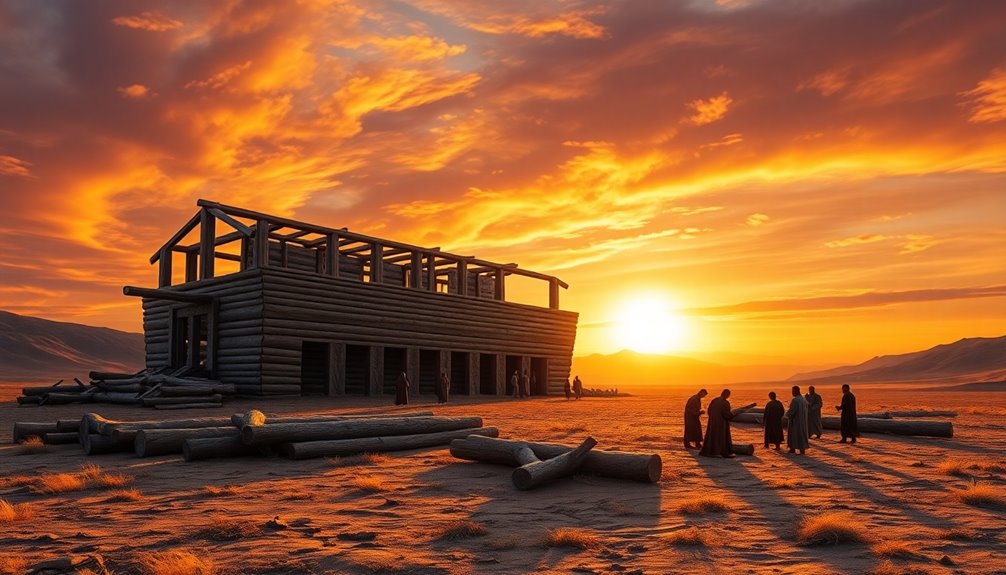
You might wonder why there's so much confusion about how long Noah took to build the ark.
Many people have misconceptions about the timeline, and skepticism often arises regarding the historical accuracy of the biblical account.
Let's clear up these common misunderstandings and explore what the scriptures really say.
Address Common Misconceptions
Misunderstandings about Noah's ark construction timeline often stem from a misreading of biblical texts. Many people assume quanto tempo Noé demorou para construir a arca is specified in the Bible, but that's not the case.
Instead, the scriptures suggest a timeframe of approximately 100 years based on Noah's age at critical events. Genesis 6:3 mentions a período de 120 anos, which some interpret as the time allowed for humanity to repent before the dilúvio, rather than the length of time Noé spent building the ark.
Noé was 500 years old when he started having sons and 600 years old when he entered the ark, leading to estimates that the construction could have taken around 50 to 100 years. However, the lack of a clear start date for the ark's construction creates confusion.
The Bible doesn't detail when Noé received as instruções de Deus relative to his sons' births.
Ultimately, understanding these interpretations within their contexto bíblico is essential. The 120 years might represent divine grace for repentance rather than the construction period, highlighting the need for careful reading and context when exploring Noah's story. Additionally, the concept of trust issues with boyfriends can be related to the misunderstandings that arise when communication is unclear, paralleling the confusion in interpreting the timeline of the ark's construction.
Skepticism About Historical Accuracy
Questioning the historical accuracy of Noah's ark construction timeline often leads to confusion and skepticism. Many wonder quanto tempo Noé realmente levou para construir a arca.
The Bíblia não diz exatamente quanto tempo foi necessário, which opens the door to various interpretations. Some scholars connect the período de 120 anos mentioned in Genesis 6:3—an allowance for humanity to repent before the dilúvio—with the timeline for ark construction.
However, if you consider that Noé was 500 when he began and 600 when the Flood came, it suggests a construction period of roughly 100 years. This brings up speculações about the feasibility of such a timeline.
Additionally, historical skepticism arises due to the lack of archaeological evidence supporting the ark's existence, further complicating the story of Noé.
As you explore the história de Noé, it's essential to recognize that cultural myths and interpretations can blur the lines between fact and fiction. This blending creates confusion around the ark's construction timeline, leaving many questioning the biblical account's reliability.
Ultimately, understanding these nuances can help you navigate the complexities of this ancient narrative.
Faith in Challenging Times
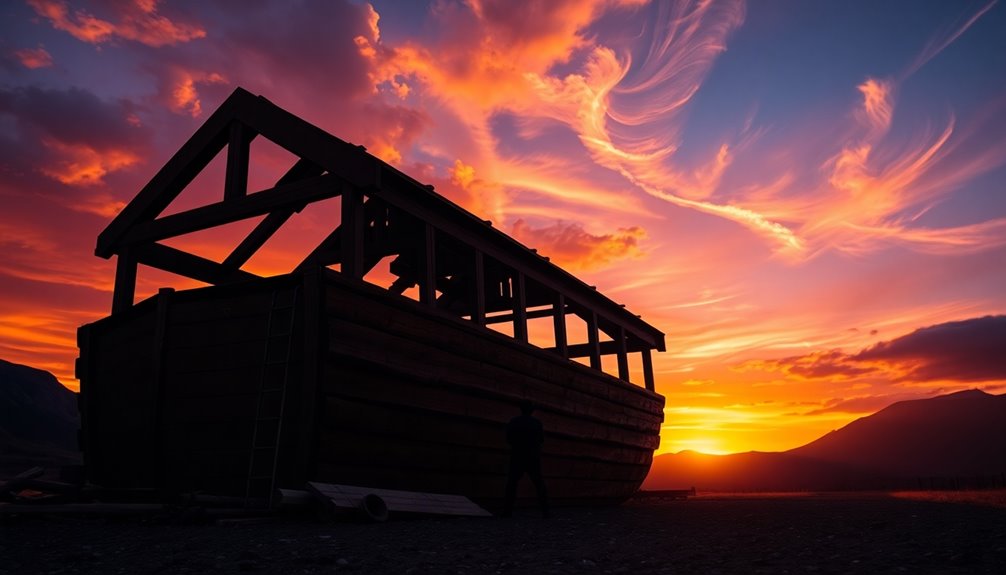
In tough times, faith can be your anchor, just like it was for Noah while he built the ark amidst doubt and ridicule.
His commitment not only shaped his own journey but also offered a glimmer of hope and resilience to those around him.
When faced with adversity, your faith can inspire both personal strength and community support.
Faith During Difficult Times
Amidst life's storms, faith can become your anchor, guiding you through the toughest challenges. Just look at Noé, who dedicated nearly 100 years to the construção of the arca. His unwavering fé in God's command, despite skepticism and ridicule from the humanidade around him, shows that true obediência often requires immense confiança.
This prolonged journey was no easy feat; it tested his perseverance and patience. Many days, the flood felt distant and invisible, yet Noé remained committed. He understood that faith is a long-term journey, and through every nail and plank, he built not just an arca but also a symbol of esperança for what was to come.
Even as he faced opposition, Noé preached righteousness, sharing his faith and reminding others of the importance of trust in divine guidance. His story illustrates that during difficult times, holding onto your beliefs can provide clarity and direction.
Community Resilience Through Faith
Community resilience often stems from a shared belief in something greater than oneself, and Noah's story exemplifies this truth. As you reflect on Noé's journey, consider how his unwavering fé and compromisso to build the arca over decades ignited a sense of hope within his community.
Despite facing skepticism and ridicule, he demonstrated remarkable obediência to God's commands, embodying perseverance in the face of disbelief. Noé's construction of the arca wasn't just about survival; it represented a physical manifestation of faith and preparation for the impending julgamento.
His dedication inspired a few to reconsider their own beliefs, fostering a sense of unity amidst collective apathy. The challenges he faced highlight that true faith often requires steadfastness, as you may find in your own life. In times of adversity, remember that small mistakes can often lead to larger issues if not addressed, just as Noé's commitment to his mission guided him through doubt and difficulty.
When you encounter tough times, remember how Noé maintained his focus on God's promises. His efforts remind you that community resilience is built not only on shared experiences but also on a collective commitment to hope and faith.
In embracing these values, you too can contribute to a stronger, more resilient community, even when faced with uncertainty and doubt.
Noah's Faith During Construction
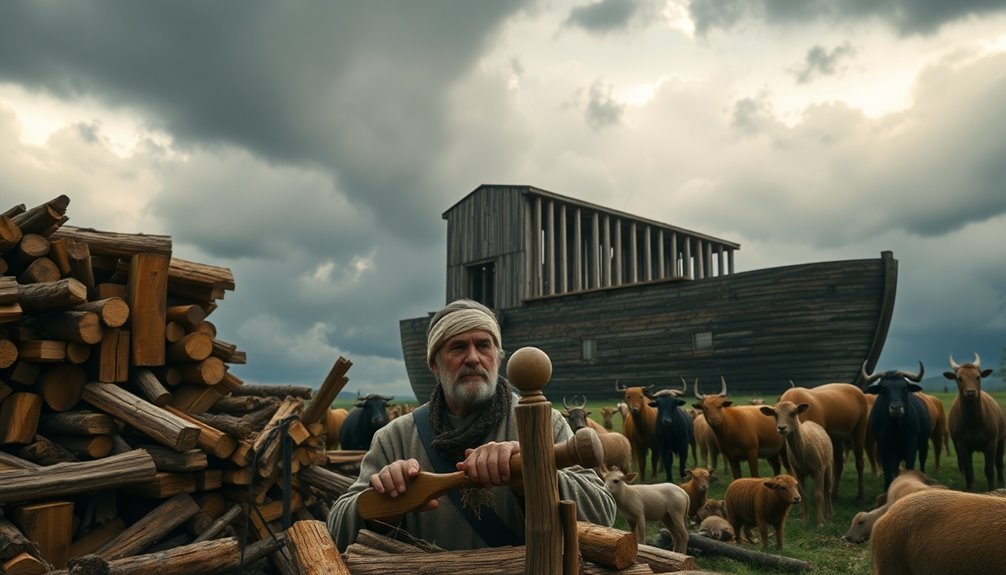
Noah's faith during the construction of the ark is a powerful testament to his obedience and trust in God. For around 50 to 100 years, Noé dedicated himself to building the arca, following God's instructions despite the skepticism and ridicule from those around him. This long period of construção required immense fé and a strong sense of obediência, as he worked tirelessly without any immediate sign of the impending dilúvio.
While laboring on the ark, Noah exemplified perseverance, remaining steadfast in his mission even when others dismissed his warnings. He not only focused on the physical construction but also took on the role of a preacher of righteousness, urging others to heed God's promise of judgment.
Noé's actions weren't just about building a massive boat; they represented his commitment to God's divine plan for humanity's preservation. Each beam and nail symbolized his unwavering trust in God's promises.
Through his dedication, Noah showcased a profound example of faith, demonstrating that true obedience often requires patience and a willingness to stand firm in the face of doubt.
Additional Resources

When exploring the depths of Noah's journey in building the ark, you'll find a wealth of additional resources that can enhance your understanding. To grasp quanto tempo Noé levou para construir a arca, it's essential to delve into the Bíblia. The narrative provides insight into God's instructions, emphasizing the importance of faith and obedience amid skepticism.
One key resource is the timeline of events surrounding the dilúvio, which indicates that Noah was around 500 years old when he began this monumental task and 600 years old when he entered the ark. This timeframe suggests a construction period of approximately 100 years, showcasing Noah's unwavering commitment to fulfilling God's directives despite the challenges he faced.
Books, documentaries, and commentaries on the biblical account can further illuminate the story, especially regarding the logistics of gathering and caring for the animais.
Engaging with these materials can deepen your appreciation for Noah's faith and the monumental effort involved in this divine project. By exploring these resources, you'll gain a clearer picture of the remarkable journey that shaped humanity's future.
Frequently Asked Questions
How Long Did It Take Noah to Build the Ark?
You might wonder how long it took Noah to build the ark.
While the Bible doesn't provide an exact timeframe, estimates suggest it could've taken anywhere from 50 to 100 years.
Noah, starting at 500 years old, demonstrated incredible faith and perseverance, working tirelessly despite the skepticism around him.
His commitment to God's command reflects a profound dedication, emphasizing how important it's to stay faithful, even when immediate results aren't visible.
Where in the Bible Does It Say That Noah Preached for 120 Years?
The Bible doesn't explicitly state that Noah preached for 120 years. Instead, Genesis 6:3 mentions God's Spirit wouldn't strive with man for that time, hinting at a period for repentance.
Some interpretations suggest this timeframe coincides with Noah's construction of the ark, during which he warned others of impending judgment.
In 2 Peter 2:5, Noah's called a "preacher of righteousness," indicating he did, in fact, warn people during that time.
How Long Did Noah Wait to Be Able to Leave the Ark?
You'll find that Noah waited about 370 days in the ark.
This duration included the flood and the time it took for the waters to recede before he could safely leave.
On the 17th day of the second month, he entered, and he didn't step out until the following year's 27th day of the same month.
His patience during this period highlights his unwavering faith and obedience to God's promise.
How Long Did Noah Preach Before the Flood?
Noah preached for about 120 years before the Flood, warning people of the impending judgment.
You can imagine the determination it took for him to remain faithful despite the constant rejection. He called for repentance, acting as a herald of righteousness, yet most ignored his message.
It's a powerful reminder of how often people dismiss divine warnings, focusing instead on their own ways while disregarding the consequences of their actions.

